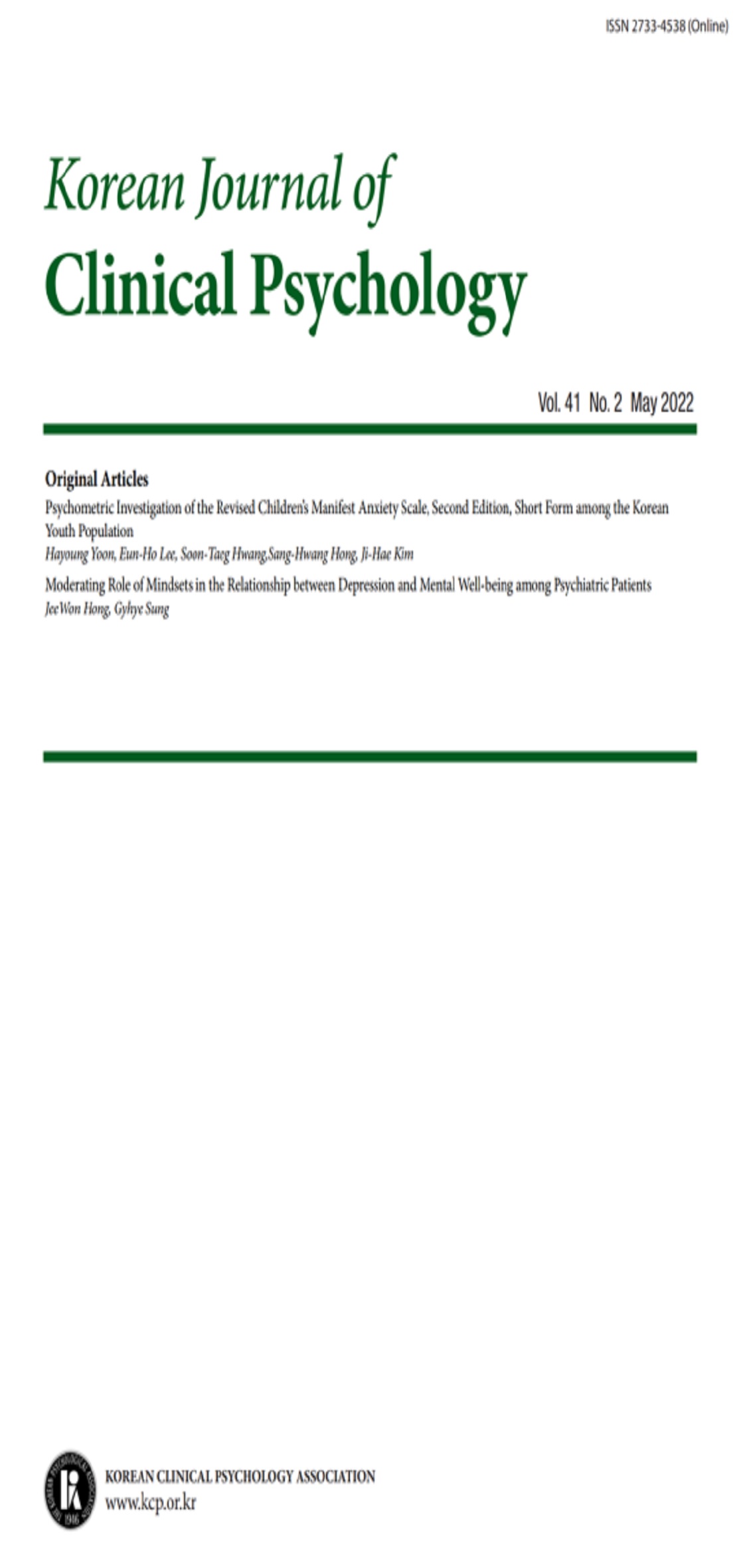open access
메뉴
open access
메뉴 E-ISSN : 2733-4538
E-ISSN : 2733-4538
본 연구에서는 집단 따돌림의 방관자가 집단 따돌림에 관심을 가지고 피해학생들에게 도움을 줄 수 있도록 방관자를 대상으로 한 또래지지 프로그램을 실시하여 그 효과를 알아보았다. 중학교에서 자기 보고에 의해 방관자로 선택된 여학생들을 대상으로 집단 상담을 실시하였다. 실험학급에서 방관자로 선정되어 또래지지 프로그램을 실시한 실험집단 학생들은 21명이었고, 통제학급에서 방관자로 선정되어 아무런 처치도 가하지 않은 통제집단 학생들은 27명이었다. 또래지지 프로그램은 총 8회기로 구성되며, 초반부에는 학생들이 집단따돌림현상에 대해 인식하고 그에 대한 다양한 시각을 가지며 피해학생에 대한 공감능력을 증대시키도록 하였으며 후반부에는 피해 학생들에게 도움행위를 주거나 전체학급에서 시행될 수 있는 집단 따돌림의 개선방안에 대해 함께 모색하도록 하였다. 연구결과는 또래지지 프로그램에 참여한 실험 집단학생들이 따돌림상황에 대한 관심을 가질 수 있었으나 실제적으로 피해자를 도울 수 있는 도움행동 및 따돌림상황에 대한 변화는 주지 못하였다. 이러한 연구 결과들을 종합하여, 결과들의 시사점과 본 연구의 의의, 제한점 및 후속 연구에 대한 제언에 관해 논의하였다.
This study investigated that the peer-support program for the outsiders of the bullying who can concern about the bullying and help the victims were completed and evaluated an effect on the program. This study was completed in 2 schools, and each school has an experimental class and a controled class. Experimental groups who completed the program from selecting as the outsiders in the experimental classes were 21 members and controled groups from selecting as the outsiders in the controled classes were 27 members. The peer-support program was composed of 8 sessions. The first part of the program was focused on the awareness about the bullying, various perspectives about the bullying, and increasing the empathy about the victim. The last part of the program was focused on helping behavior to the victim and improvement methods of the bullying which can be carried out in the class. The study effect was that experimental groups who participated in the program increased the concern about bullying situations. However, experimental groups did not have significant changes in the bulling situation and the helping behavior to the victim. We discussed about the suggestion of the result, the meaning, the restriction of this study and the following study.
(1997) 청소년의 집단 따돌림의 원인과 지도방안. 청소년대화의 광장,
(1999) 한국의 왕따 현상의 개념화와 왕따 연구의 방법론적 고찰,
(1999) 초등학생의 생활만족도 형성요인에 대한 구조적 관계분석: 사회적 지원과 자기 효능감을 중심으로,
(2003) 정서 및 인지적 차원으로 구분한 초등학교 왕따 방관자의 유형 및 도움행동에 관한 연구,
(1997) 학교폭력 피해 청소년의 정신의학적 후유증에 관한 사례 연구,
(2001) 또래아동의 비행 행동이 피해아동의 삶의 질에 미치는 영향 및 그 개선방안-집단괴롭힘 소위 ‘왕따(bullying)’를 중심으로,
(2000) 집단따돌림 경험 유형에 따른 자기개념과 사회적지지,
(2000) 학교에서의 집단 따돌림: 특성 및 실태,
(2001) 초등학생들의 집단 괴롭힘 가해행동과 피해행동에 대한 사회적, 심리적 예측변인들: 학년과 성별을 중심으로,
(1999) 집단 따돌림 해결을 위한 학교 모델. 따돌림 해결을 위한 현장모델 개발, 9
(2002) 공감과 동조가 집단 따돌림 피해자와 가해자의 지각에 미치는 영향,
(2001) 집단 따돌림의 측정방법에 따른 행동평가의 차이: 자기평가와 동료평가의 비교,
(2002) 출구 없는 곳으로 내몰린 10대,
(2002) 집단 따돌림의 진단 및 치료방안, 서울: 집문당.
(1997) 따돌리는 아이들, 따돌림 당하는 아이들. ,
(2002) Daum 설문조사 2002년 4월,
(1996) Assessment of bullying/victim problems in 8 to 11 years- old,
(1992) . Do girls manipulate and boys fight? Developmental trends in regard to direct and indirect aggression. Aggressive Behavior,
(1996) The effects of a short video intervention on secondary school pupils' involvement in definitions of and attitude towards bullying,
(1995) Friendship protects "at risk" children from victimization by peers. In J. M. Price (chair). The role of friendship in children's developmental risk and resilience: A developmental psychopathology perspective.,
(1994) pathway of youth in out time. Cambridge, Cambridge University Press
(2000) Bystanding or standing by: Gender issues in coping with bullying in english schools,
(1997) Observations of bullying and victimization in the schoolyard. ,
(1968) Bystander intervention in emergencies diffusion of responsibility. Journal of Personality and Social Psychology,
(1990) . Stability of victimization in elementary school children. Unpublished master's thesis, Florida Atlantic University
(1996) Searching for resilience among African-American youth exposed to community violence: theoretical issues,
(1996) Bystanders: an overlooked factor in peer on peer abuse,
(1997) Individual risk and social risk as interacting determinants of victimization in the peer group.,
(1994) . Aggression and peer victimization as predictors of self-report of behavioral and emotional adjustment. Poster presented at the biennial meeting of the conference on Human Development,
(1995) Features of aggressive and victimized children's friendships and affilative preference.,
(1999) The effectiveness of peer support systems in challenging school bullying: the perspectives and experiences of teachers and pupils,
(1999) Peer involvement in bulling: insights and challenges for intervention,
(1994) Bullying at school Basic facts and effects of a school based intervention program. Journal of Child Psychology and Psychiatry. 7,
(1996) Bullying and the Steiner school ethos: a case study analysis of a group centered educational philosophy.,
(1996) Bullying as a group process: Participant roles and their relations to social status within the group.,
(2001) Peer-led intervention campaign against school bullying: who considered it useful, who benefited,
(2002) Targeting the group as a whole: The finnish anti-bullying intervention,
(1999) Bullying as a group process: An adaptation of the participant role approach,
(1993) . A survey of the nature and extent of bullying in junior/ middle and secondary schools. Educational Research,
